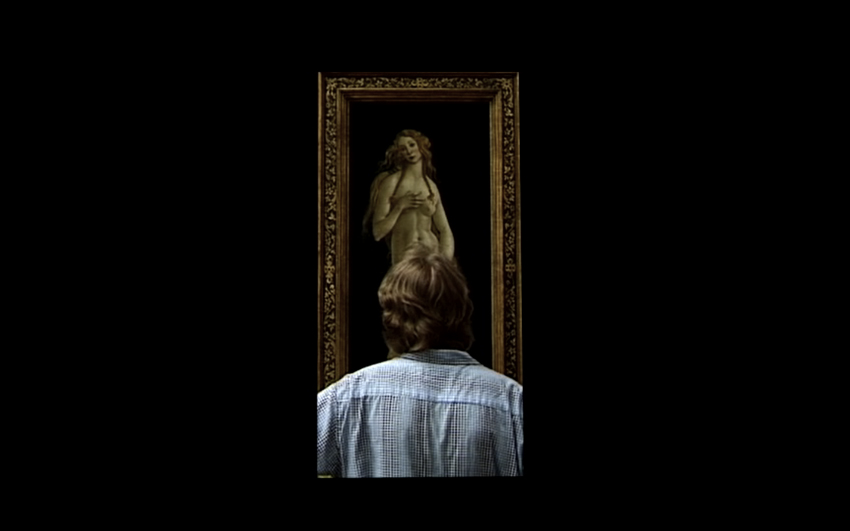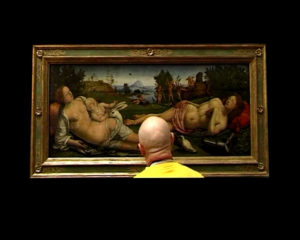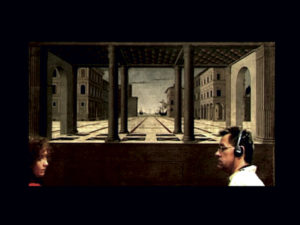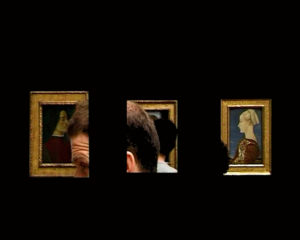Museum Video still, 2002, Sammlerfamilie 4 channel (1) DVD 15‘00‘‘
link to the video
During one day in 2002, in the Gemeldegaleri – Staatliche Museen in Berlin, six paintings were filmed using four cameras. The films where shot during the working hours of the museum in one of the exhibiting rooms where all the paintings were (and still are) hung. In 2006 the work “Museum” was exhibited in Gallery. In one of the exhibiting spaces of the Gallery four projectors were showing these filmed works:
Projection 1: “Architectural Veduta” Francesco di Giorgio Martini, (about 1490/1500),
Projection 2: “Portrait of Simonetta Vespucci” Sandro Botticelli (about 1476/1480), “Portrait of Giuliano de’ Medici” Sandro Botticelli (about 1478), “Profile of the young woman” Piero del Pollaiuolo (about 1465)
Projection 3: “Venus, Mars and Amor” Piero di Cosimo (about 1505)
Projection 4: “Venus” Sandro Botticelli (about 1500)
The projected works give us insights to the period of the Renaissance. We can see in the pictures how they looked – their clothes, hairstyle, social class, beauty ideal, behavior, mythology, architecture etc. Some of the persons in the painting are naked (Projection 4) , some half naked (Projection 3) and some fully clothed (Projection 2). What happenes when we are in the space where the “Museum” is exhibited?Several questions are raised automatically.
Do we: observe the paintings or the filmed paintings?; observe art from the Renaissance?; art from the beginning of the 21st century?; or contemporary art? observe the observers, of different times? observe copies or originals…? Let’s unfold this work, layer by layer.
What do the viewers get to see? The act of exhibiting filmed paintings as videos changes the meaning of the origin of these works. The paintings are no longer paintings, nor are they only projected pictures of the paintings, because from time to time we can see the visitors of the museum in the picture, as they are observing the paintings. So in the “Museum” we don’t observe only paintings, we also observe the time when this film was shot, from the perspective of the present.
What do the viewers hear? On the projected pictures we can see, for example, the architecture of that time (“Architectural Veduta”) and at the same time hear the echo of the museum rooms, where the film was shot. We can hear the steps of the museum visitors, children screaming, the small talk of the museum visitors etc. But the gallery visitors during their walking through the gallery also make their own sounds or noises. So the sounds of the gallery visitors start to mix with the sounds of the museum visitors, which creates total confusion in the space.
What do the viewers observe? When we watch the “Museum” we watch three different times/epochs, of the paintings, of the museum visitors and gallery visitors. In this work we see the people that were observing the paintings that day. They stay in front of the paintings – some watch them a short time, some longer. People watch and talk to each other. When we are in the room, we look and compare the style of the Renaissance and the style of the museum visitors. We see the similarities and the differences of the people that lived in the Renaissance and those from the year 2002. And then there is another dimension, the gallery visitors. They also get in the picture from time to time and “disturb” the projected images. In that moment we get several layers that we can compare. This opens the question: what kind of observation is this? Observing the observer, observing the observer of the observer, or both at the same time?
Original or copy? The next question concerning the museum is: is this work a copy or an original? First of all, we cannot talk about any kind of original or copy in the usual way. For one, the original works are painted on a canvas and the ones in the “Museum” are digital films, or rather projected light. So the basic materials of the presentation are complete opposites. The “Museum” does not try to copy the original. The ”Museum” uses the paintings as objects for the film, or a kind of stage, where the actors (museum visitors) come, act and leave. With the above mentioned factors, the “Museum” includes several different layers more than the original. The work carries different information from the original, so the “Museum” behaves as a work itself.
How could we categorize this work? An original with some other quality? A different original? An original which is different from the origin? A different category of the original? Or just an original?
Where are the Gallery Visitors placed? Do the Gallery visitors find themselves in the gallery, in the museum or in both places at the same time? What kind of situation do we have in this case?A museum is exhibited in a gallery. One space inside another. Two spaces existing at the same time in the same place. If there are two spaces in one room, can we call that a state of parallel spaces? How can we name this?
What is the “Museum”?
Through the “Museum”, the gallery room becomes a museum room, so the space changes its previous character and loses its original meaning. If four museum walls were the paintings hung were filmed, and those videos get projected on four walls of the gallery, are we dealing with a kind of space transporter? The “Museum” does preserve the painting and the space in some way, but also the time when the video was shot. So could we call the “Museum” a “time machine”? Or a trip to different times at the same time? If a museum inter alia has the function to collect and save significant works to preserve history, then the “Museum” does exactly that and also includes some other layers. Is then a “Museum” a museum? If yes, what kind of a museum? A virtual/digital/mobile museum, or something else? One of the many questions that this work leaves open is how will the people after a period of time in the future look at this work? Does the future of the museum through the “Museum” change its previous shape? Or, will the museum still keep the form it had until now? Apart from raising so many questions, the “Museum” certainly gives us one answer. The “Museum” opens a different field of opportunities for a different way of seeing the museum or a different possibility of how the museum can be treated in the future.
Museum Video still, 2002, Sammlerfamilie 4 channel (2) DVD 15‘00‘‘
Museum Video still, 2002, Sammlerfamilie 4 channel (3) DVD 15‘00‘‘
Museum Video still, 2002, Sammlerfamilie 4 channel (4) DVD 15‘00‘‘



